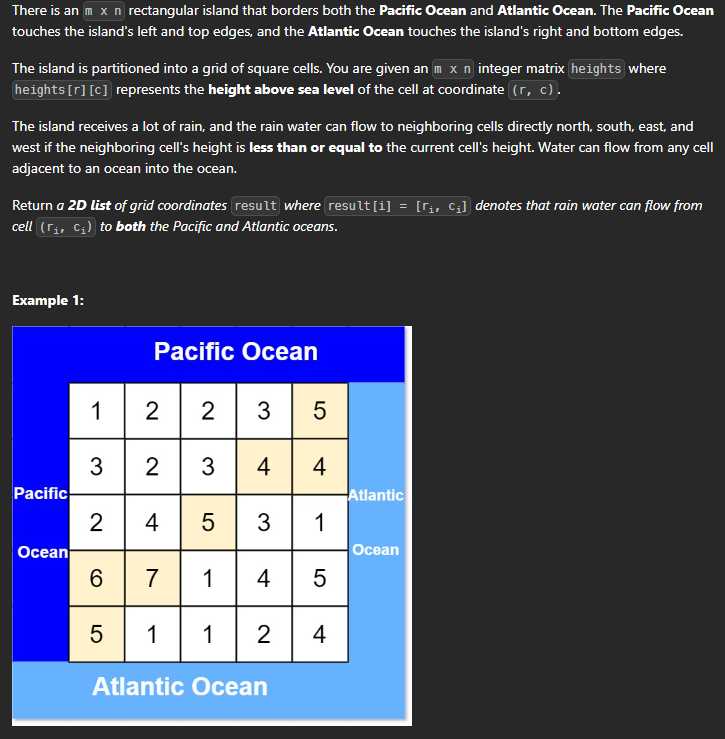Pacific Atlantic Water Flow
Description

Problem Link : Pacific Atlantic Water Flow
Solution
Approach for this :
- Lets first discuss how to appraoch this problem and arrive at a solution.
- We have to return the cells which can flow to both the oceans.
- We can use the dfs approach to solve this problem. We will start from the cells which are on the border of the matrix.
- And we will keep track of all the cells that can reach the oceans.
- At last the cells reaching both the oceans will be considered as the answer cells.
Lets look at bfs approach first :
class Solution {
public:
vector<pair<int, int>> directions = {{-1, 0}, {0, -1}, {1, 0}, {0, 1}};
int n, m;
void bfs(vector<vector<int>>& heights, vector<vector<bool>>& visited, queue<pair<int, int>>& q) {
while (!q.empty()) {
auto [x, y] = q.front();
q.pop();
for (auto it : directions) {
int nx = x + it.first;
int ny = y + it.second;
if (nx >= 0 && nx < n && ny >= 0 && ny < m && !visited[nx][ny] && heights[nx][ny] >= heights[x][y]) {
visited[nx][ny] = true;
q.push({nx, ny});
}
}
}
}
vector<vector<int>> pacificAtlantic(vector<vector<int>>& heights) {
n = heights.size();
m = heights[0].size();
vector<vector<int>> ans;
vector<vector<bool>> pac(n, vector<bool>(m, false));
vector<vector<bool>> atl(n, vector<bool>(m, false));
queue<pair<int, int>> pq;
queue<pair<int, int>> aq;
// First and last row
for (int i = 0; i < m; i++) {
pq.push({0, i});
aq.push({n - 1, i});
pac[0][i] = true;
atl[n - 1][i] = true;
}
// First and last column
for (int i = 0; i < n; i++) {
pq.push({i, 0});
aq.push({i, m - 1});
pac[i][0] = true;
atl[i][m - 1] = true;
}
// Perform BFS for the Pacific Ocean
bfs(heights, pac, pq);
// Perform BFS for the Atlantic Ocean
bfs(heights, atl, aq);
// Find the cells reachable from both oceans
for (int i = 0; i < n; i++) {
for (int j = 0; j < m; j++) {
if (pac[i][j] && atl[i][j]) {
ans.push_back({i, j});
}
}
}
return ans;
}
};
Time Complexity : O(n*m)
Space Complexity : O(n*m)
- Lets look at dfs approach now :
class Solution {
public:
vector < pair < int, int >> directions = {{-1, 0}, {0, -1}, {1, 0}, {0, 1}};
int n, m;
void dfs(vector < vector < int >> & heights, vector < vector < bool >> & visited, int x, int y) {
visited[x][y] = true;
for (auto it: directions) {
int nx = x + it.first;
int ny = y + it.second;
if (nx >= 0 && nx < n && ny >= 0 && ny < m && !visited[nx][ny] && heights[nx][ny] >= heights[x][y]) {
dfs(heights, visited, nx, ny);
}
}
}
vector < vector < int >> pacificAtlantic(vector < vector < int >> & heights) {
n = heights.size();
m = heights[0].size();
vector < vector < int >> ans;
vector < vector < bool >> pac(n, vector < bool > (m, false));
vector < vector < bool >> atl(n, vector < bool > (m, false));
// First and last row
for (int i = 0; i < m; i++) {
dfs(heights, pac, 0, i);
dfs(heights, atl, n - 1, i);
}
// First and last column
for (int i = 0; i < n; i++) {
dfs(heights, pac, i, 0);
dfs(heights, atl, i, m - 1);
}
// Find the cells reachable from both oceans
for (int i = 0; i < n; i++) {
for (int j = 0; j < m; j++) {
if (pac[i][j] && atl[i][j]) {
ans.push_back({i, j});
}
}
}
return ans;
}
};
Time Complexity : O(n*m)
Space Complexity : O(n*m)